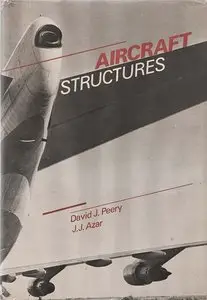David J. Peery, Jamal J. Azar, "Aircraft Structures, Second Edition"
MgH | 1982 | ISBN: 0070491968 | 470 pages | PDF | 21,1 MB
MgH | 1982 | ISBN: 0070491968 | 470 pages | PDF | 21,1 MB
The longevity of the original Peery text (1950) is due in part to its fundamental excellence and to limited progress in aircraft structures, such as it was in a 30-year period marked by preoccupation with space and severely retrenched research and development activity. Nevertheless, after three decades, a suitably revised and extended book would appear to have merit, particularly with regard to topics that bear on the design of aircraft structures to reflect improved structural efficiency and reliability.
Publicity accompanying the text makes the claim that the new edition has been brought completely up-to-date. Unfortunately, such is not the case in substance. New material is included indeed; however, it extends in independent chapters only to elasticity of structures, the finite element stiffness method, and thermal stresses.
New material added within existing chapters is relatively limited and more informative in nature than utilitarian. Including the three new chapters, the second edition of twelve chapters replaces the first-edition of eighteen chapters, either by reorganization or elimination of original material. Except for the three new chapter coverages added, the major portion of the first-edition text has simply been reset and the origina figures redrawn, although to larger scale. The question is begged, therefore, as to whether the overall tradeoff is in the reader's favor.
For a textbook aimed at undergraduate students, seniors to be specific, the three new major coverages must be assessed in the light of their relevance to the aircraft structures theme per se. A chapter on the fundamentals of three-dimensional elasticity theory can be justified, of course, but only if the subsequent structural analysis developments are carefully related to elasticity theory and departures therefrom as they unfold. There is little opportunity to do so, however, as only two of the nine chapters which follow contain topical material and illustrative examples different from the first edition, a masterful exposition of the stress and deflection analysis of trusses, space frameworks, and the built-up sheet- stringer or semjmonocoque construction so common to flight vehicle airframes for five decades now.
Elasticity theory appears in the separate and brief chapter .on thermal stresses; however, illustrative examples are given only for a beam and a three-bar truss, respectively. With regard to thermal effects, they are fundamental to the constitutive equations of elasticity theory. Thus, they are conspicuous by their absence when the stress-strain relations of elasticity theory are first introduced.
The chapter on the finite element stiffness method is the significant new contribution to the book. Here a powerful and increasingly popular methodology is introduced to students, with the expertise of co-author Azar in this area obviously apparent. Unfortunately, all but one of the illustrative examples of the technique are restricted to this chapter. The three-bar truss example in the chapter on thermal stresses is the remaining instance. The analysis and design of typical members of aircraft structures which follow the introduction of the discretization approach use mainly conventional and, in one instance, finite difference methodology. These applications are basically similar to, if not the same as, their counterparts in the first edition.
If the aim of the revised text is simply to make students aware of some of the new developments and areas of interest which have surfaced in the period of the past three decades, then perhaps the objective has been attained. On the other hand, if the new thrust is supposed to be all-inclusive and to have the students learn to implement new theory and analysis techniques, then the goal has not been realized. For example, although laminated composite materials do not appear as an entry in the subject index, they are mentioned in several places in the text. In no illustrative example, however, is a laminate other than a unidirectional one considered; further, no connection is drawn between anisotropic composites and the general anisotropic medium for which constitutive relations are presented in the chapter on theory of elasticity. In a basic reference text which includes matrix methods, transformation of stress and strain, the definition of an orthotropic medium, mention of composites and their tailoring potential, and the concept of stress resultants, relatively little additional space would have to be accorded development of, say, composite plate extensional, coupling, and bending stiffnesses referred to overall laminate axes.
The referencing system used in the revised edition is frustrating to the reader. Although 104 entries appear in the reference list, less than half actually appear in the text; the references that can be identified are woefully out of order. Further, at least one reference has been located in the text which is absent from the reference list. In addition, few of the 30 or so references dated 1970 or later can actually be found in the body of a book which is purported to be up-to-date.
In summary, then, it would appear that there is insufficient inducement for those holding the first edition to invest in the second edition. For others, until the first edition copies are exhausted, the choice is arbitrary in view of the large portion of text that is common to both.
Download



